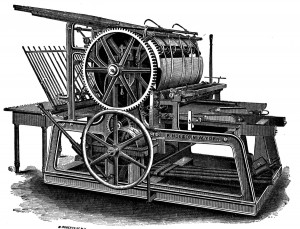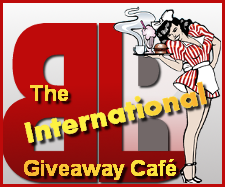Book Lovers Inc.
Romance Novel Reviews, Author Interviews, Commentary
Elements in Lit 201: The Publishing World
Up until now, we’ve talked about book content, genres, and other things of the sort. Thanks to some of the other BLI’ers, today we’re going to take a look at the business behind the books that we love. Publishing involves a whole lot more than just writing a book, getting it into print, then into the readers hands. As book reviewers, we have our own place in the process now, but let’s see what else is involved in the wide world of publishing:
Publishers come in all shapes and sizes. Within publishers, there are also “imprints”. For our purposes here, we’re going to discuss the definition  of imprint that refers to the trade name that books are published under (though there are several different meanings, as can be found on the Wiki page). These are usually grouped into similar styles of books, like Tor, part of Macmillan, works mainly with Science Fiction and Fantasy. In fact, the large publishers, all have a slew of imprints under their main company names. Here are some examples:
of imprint that refers to the trade name that books are published under (though there are several different meanings, as can be found on the Wiki page). These are usually grouped into similar styles of books, like Tor, part of Macmillan, works mainly with Science Fiction and Fantasy. In fact, the large publishers, all have a slew of imprints under their main company names. Here are some examples:
Hachette Book Group has Little, Brown, Grand Central, Faith Words, Mulholland to name a few.
Macmillan as mentioned before is the main company for Tor Forge and Tor Orb, but also St. Martin’s Press and Henry Holt & Co. (click on the link then scroll over the “Publishers” tab for a comprehensive list).
Simon and Schuster lays claim to Atria, Pocket, Scribner, Simon Pulse and more.
Random House contains Doubleday, Crown Publishing, Del Rey, Ballantine, Bantam plus tons more.
Penguin Group is home to Viking, Ace, Berkley Books, and Razorbill (and lots more).
HarperCollins has Avon Books, William Morrow, and Ecco as a few of its more well known imprints.
They all sound familiar right? And this is just a small sampling of what the major publishing houses have under their belts. But beyond these very well known names, there are other types of publishers out there. Indie presses or Small Presses are not affiliated with the larger houses and are  defined by having less than $50 million in sales per year. According to this site, the small presses “tend to fill the niches that larger publishers neglect” by specializing either by genre, geographic region, or a particular “niche” audience.
defined by having less than $50 million in sales per year. According to this site, the small presses “tend to fill the niches that larger publishers neglect” by specializing either by genre, geographic region, or a particular “niche” audience.
But small presses are also not the same as Vanity presses. The vanity press is one that seems to be gaining in popularity because they can get authors’ books put into print, or e-format, by charging the authors to print the books. The publishing house makes it’s money from the author who in turn can sell their books however they wish. I’d like to assume that this means the author would get the full value from sales rather than a percentage as offered by the traditional publishers. What I found most interesting about the Vanity presses was its list of illustrious clients: Lewis Carroll, Mark Twain, Edgar Rice Burroughs, Edgar Allan Poe, and Rudyard Kipling all self-published at some point in their careers.
That might actually be a bit incorrectly worded because an author can choose to forego the entire process of involving another business and just print their own books from start to finish, especially with the “print on demand” availability. This is the true meaning of “self-publishing“. It also involves any cover art, editing, pricing, retailing and so on that a publisher would usually look after in the process of book release. If you ask any author these days, you’ll see that they still have a lot of work to do anyway to promote their books. To this end, it seems some well known authors are choosing to go this route now also, like J.K. Rowling will be for her e-versions of the Harry Potter Series. Wow!
Now, here’s my challenge for you all: Check out the books on your shelves and see what imprints you have. Do you have lots from one in particular or are they all varied? Also, please let me know if I missed any big names. I was thinking about Harlequin and where it would fit, but I might leave that one for a dedicated post 🙂
I’d hoped to be able to fit in some other facets of publishing, like the ARC versus the galley; is there a difference? What is it? But we’ll take a look at that next time.
Share This Post
Subscribe and stay up-to-date
4 Comments
« Review: Bare Naked Lola by Melissa Bourbon Ramirez Next Post
Interview with Alice Wade + Giveaway Awesomeness! »















 Blog RSS Feed
Blog RSS Feed Follow Me on Twitter
Follow Me on Twitter My Facebook
My Facebook
Challenge Accepted! This is much harder than usual since I just got two GORGEOUS new bookshelves and am in the process or organizing them. I spy with my little eye….
Ace
Anchor
Angry Robot
Apex
Aspect
Avon
Avonova
Baen
Bantam
Candlemark & Gleam
DAW
DelRay
EOS
Firebird
Gollancz
Grove
Harper Prism
Harper Torch
Houghton Mifflin
Luna
Mira
NeDeo
Night Shade
Norton
Orb
Orbit
Perigee
Prime
Prime
Roc
Scholastic
SFBC
Spectra
Tachyon
Thomas Dunne
Tor
Viking
Vintage
Warner
White Wolf
Wordcraft
WOTC Discoveries
Keep in mind these are just the paperback currently set to fit on my new shelf. I didn’t get up to do a thorough inventory. And haven’t considered ebooks. I don’t know about missing big names, but you definitely didn’t touch on all the publishers making a mint of my addiction.
Very interesting post Jackie, thank you! As I am reading this at the office, I get out from the challenge, but I do recognize some of those names. To tell you the truth, I am totally uninterested in a publisher. I focus on the author.
I am with Aurian, who cares about the publisher in the end 🙂
I care about publishers! I noted a SIGNIFICANT jump in cover quality amongst certain publishers.